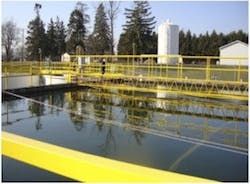As a 3.4 mgd plant built in the 1920s, the Aqua America Tiffin, Ohio, drinking water treatment plant faced the challenge of producing high-quality drinking water. With a full measure of seasonal variety combined with the runoff from a thriving agricultural environment, the small-town facility constantly encountered adverse conditions. In a short time period, influent turbidity could fluctuate from 10 to 2,000 ntu. This “flashy” water source and the area’s stringent regulations posed frequent operational difficulties.
By enhancing coagulation in the 1990s to meet treatment regulations, the plant’s sedimentation rates increased, exacerbating sludge blanket depths. Because of this, the winter months occasionally proved to be extremely problematic. With icy conditions and the inability to remove the tank from service, the plant experienced short-circuiting. As a result of these ongoing problems and frequent halting of water production, the plant sought a way to eliminate the tedious, time-consuming removal of the tanks for cleaning and improve upon the lost revenue. Needing a cost-effective, automatic solids removal solution, Tiffin opted to install Brentwood’s WEDA sludge dredging system in 2000.
Impact of a clean floor
The original self-driven equipment, in addition to the installation of a SedVac cable-driven upgrade in 2010, continues to provide optimal service for the Tiffin plant. Minimal modification to the basin made this retrofit extremely cost-effective, as the equipment generated a positive return on investment within one year. With the SedVac system in operation, the basins now require cleaning only twice per year, as opposed to once every three weeks, as had previously been required. For this small facility, these savings compute to approximately $65,000 per year.
In an effort to understand how the cable-driven SedVac sediment dredge system produced these results, Tiffin agreed to participate in a study of the system’s performance and capabilities. Over the course of 18 months, the study found SedVac to be capable of removing settled sludge with 3% solid concentrations and reliably handle heavy loads without stoppage, despite peaks in raw water quality of 2,000 ntu. By running SedVac once per day, even during peak solids loading, the system maintained a clean floor.
As a test, two SedVac units ran simultaneously in the rectangular basin—one testing vacuum removal and the other testing submerged pump suction. The discharge flow rates and solids concentration illustrate the effectiveness and consistency of SedVac’s performance. (See Figure 1 below.)
An additional side-by-side test, conducted with SedVac and a traditional tube-shaped header with orifices, produced a stark contrast in results. The data reflects the ability of the SedVac system to consistently maintain the discharge flow rate as solids concentration increases, versus clog-prone traditionally designed systems. (See Figure 2 below.)
A Non-traditional approach
By adopting a non-traditional design approach, SedVac’s header effectively cleans and scrapes the basin floor, removing the compression zone layer of sludge. Rather than utilizing commonly used orifices in the header, SedVac takes advantage of a four-inch-high opening that runs the entire length of the header. The triangular design acts as a funnel, concentrating solids in the process without clogging.
Eliminating frequent manual cleaning saved the Tiffin plant $5,000 per day. Not only does this allow for increased productivity, but it also keeps employees safe by removing personnel from potentially hazardous work conditions. Additional unexpected savings directly relating to the use of SedVac were also experienced by Tiffin—for example, the system allowed for a reduction in the frequency of filter backwashing. Also, because of the change from alum coagulants to DelPAC, the solids began settling at four times the previous rate. Therefore, instead of backwashing every 24 hours, the plant now backwashes only once every 120 to 168 hours, conserving 50,000 to 75,000 gallons of treated water per day.
As it effectively cleans the basin floor and provides additional performance-related benefits, SedVac was clearly the right solution for the challenges encountered by Tiffin. The SedVac system enabled the plant to save money, see results beyond its expectations and stay productive throughout drastic changes in raw water quality.



